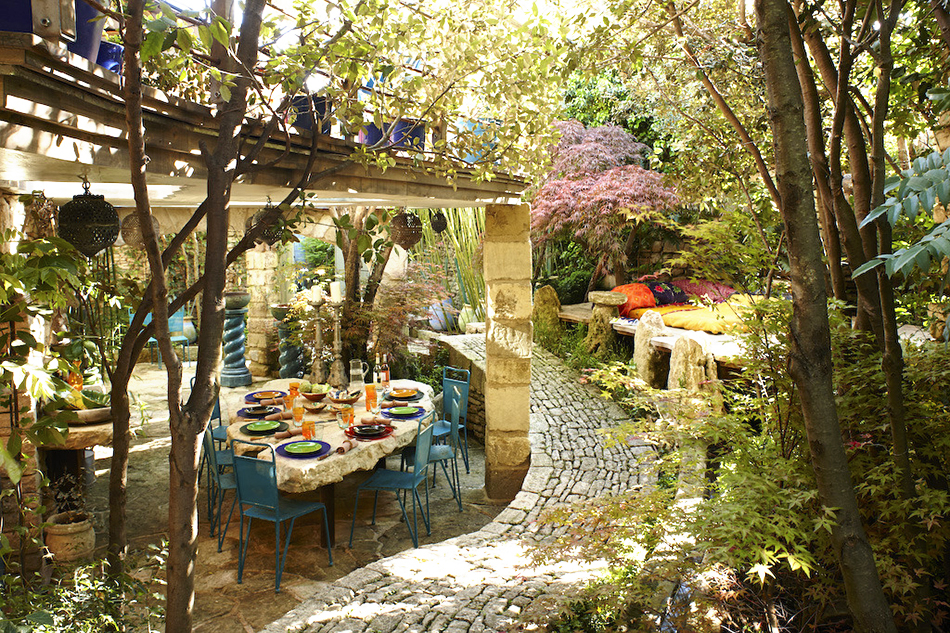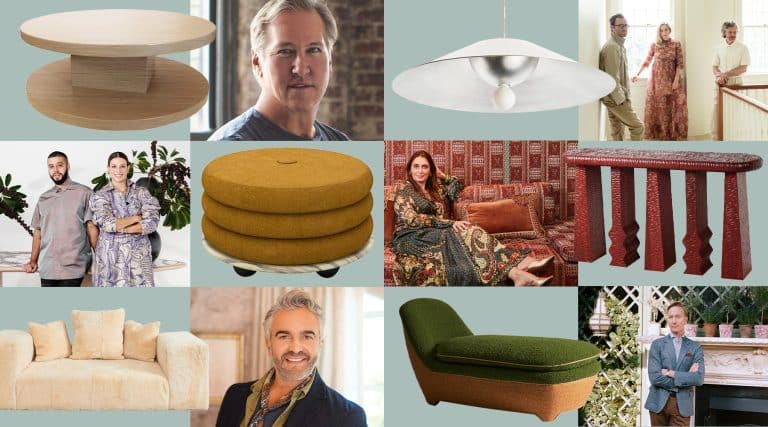
June 18, 2014In the shop, a circa-1880 chandelier made of bent bayonets hangs above a 1940s wrought-iron dining set. The 18th-century Kussenkast (Dutch cabinet) in the back is “surprisingly contemporary,” says Allaway. “Usually these are much more decorated and heavy looking.” Top: Azura Allaway and Nicod, partners in life and antiques hunting. Photos by Caroline Perrier
In the postcard-picturesque Provençal town of Isle sur La Sorgue, about 350 vendors are on hand each weekend to offer a sun-kissed array of antiques and brocante (vintage wares). Questing connoisseurs, however, make straight for the Isle’s star: the exuberant emporium on the Avenue des Quatres Otages, where Xavier Nicod runs the most exciting show in town.
Before entering the boutique, wizardly window displays catch your attention. When I first visited a few years ago, the eye-catcher was a tableau of a village scene – entirely cast in cement by an anonymous mid-century folk artist – that included two gendarmes, a gamekeeper and other locals sharing drinks around a table occupied front and center by a flamingo. In another window, a fireplace in the form of a gilded metal sunburst of flames was flanked by two simple but chic late-18th-century Provençal armchairs with woven straw seats. Last December, Nicod found two nearly life-sized plaster angels that had long ago reigned in a Casablanca church, and he whisked them from Morocco to his atelier. Following a breathtakingly fast restoration, they miraculously appeared in his window on Christmas Eve.
To explore the rest of what turns out to be Nicod’s rather labyrinthine empire, which he has been building since 1991, one passes through an iron gate to a bamboo-forested garden, more than 600 square feet of landscaped space from which you can then access all the other parts of his galleries. “It’s a boutique, and it’s not a boutique,” he says of these multifaceted spaces. “It’s a place where I want to share my discoveries.”
A second-generation dealer, Nicod was “born into the métier,” he says. “From age three or four, I was accompanying my parents on their buying trips all over France.” By 10, he was collecting and trading pieces himself. “My room was filled with twentieth-century designs, like a beautiful barbershop chair that is still at my parents’ house,” he says.
At 15, he was finding his own sources; at 20, he opened his gallery. (His parents’ first shop, since closed, was near the town’s train station. Their second gallery is now part of Nicod’s emporium.) A generous mop of sandy hair and an equally generous smile, as well as boundless curiosity, enthusiasm and energy, combine to make Nicod, now 47, the Indiana Jones of antiques. He intrepidly journeys throughout France in pursuit of the exotic, eclectic and sometimes even downright eccentric objects that amaze and amuse his loyal clientele.

The bold, rich colors of southern France are found throughout the shop and house, where Nicod and Dequiedt designed the staircase leading up to the master bedroom. The glass globes are antique fishing floats. Photo by Alexandre Bailhache
Nicod’s partner in life and work is Azura Allaway, and she’s the ethereally stylish heroine of this antiquarian adventure. Born in Provence to English parents, she was the little girl-almost-next-door in the same Luberon village where Nicod bought a house when he was 19. Then, their 15-year age difference was a chasm. Like a modern-day Gigi, their paths crossed again in 2010 at a party when they both took a revelatory second look. He invited her to come and work with him. She jumped right in, and since then Allaway has been Nicod’s partner in life as well as his co-conspirator in the search for the gallery’s dramatically varied objects.
In the more than 4,000 square feet of gallery space, a superabundance of antique trophies are corralled into Ali Baba-esque arrangements – if, that is, Baba had been a sophisticated Frenchman. The adventure starts with an installation “forest” of ecologically sourced oak saplings integrated into the décor four years ago. Peer through the trees to spot a plaster bust of Homer (its marble twin is in the Louvre) surveying a clearing from a countertop. Then, happen onto a huge terra cotta sculpture of a seated gorilla, looking rather sorry for himself, or a bluish-green Italian Art Nouveau table from a patisserie, decorated in roses and stylized flowers. “We call the table `Alice in Wonderland’ because it’s so tall it makes us feel small,” Allaway explains.
Nicod created the courtyard garden with landscape artist Erwan Dequiedt, his partner in architectural and design projects, which he has been taking on in addition to the gallery work since 2006. The alfresco space abounds with vintage outdoor furniture. In one vignette, a 1940s white wrought-iron armchair sits atop a 1950s blue metal table accompanied by four Folk Art chairs made of tractor parts and sporting feet made of horseshoes. Nearby, huge copper basins, used in chocolate- or cheese-making, await their transformations into the unconventional bathtubs that Nicod often uses in his decoration projects.

Left: Each room in the couple’s home offers a different feast for the eyes. In the bathroom off the master bedroom, a copper tub, originally used to make cheese, takes center stage. A French mirror from the 1970s hangs behind it, while Japanese prints cover the walls (photo by Alexandre Bailhache). Right: In one area of the shop, Nicod and landscape artist Erwan Dequiedt created an installation of oak saplings to give the impression of a small forest. A plaster bust of Homer is visible through the trees (photo courtesy of Xavier Nicod)

The antiques dealers in their Provençal gallery. “Sourcing is thrilling and very addictive,” says Allaway. “We want to be seduced, surprised, astonished. When the object makes our hearts beat faster, we know we’ve found it.” Photo by Caroline Perrier
Once inside, look up, and you’ll see two chandeliers – one crystal, one brass – hanging from the 23-foot-high rafters. These jostle for position with a huge, bright blue-and-yellow illuminated planisphere, below which sits an oversize desk supporting the dealers’ mascot, a 220-pound dollhouse-sized cement model of a turreted Louis XV château. In a case behind, a gilded Burmese temple guardian bares his teeth in a grin.
“The boutique is our playground,” Nicod says. “We might find a marvelous table, then find another and put it on top, then put more objects on top of that. Things are mixed, one thing in front of another. We could easily take the objects we have amassed in one-hundred square feet of the gallery and present them on podiums spaced out over one-thousand square feet in a minimalist New York style where you see everything at a glance.”
Since joining Nicod at the gallery, Allaway has strengthened the focus on historical research. But, for both of them, the hunt is still about the excitement engendered by the object – what Nicod calls a “coup de coeur” (which roughly translates as “a thunderbolt of desire”) – rather than a quest for a famous name. “Sourcing is thrilling and very addictive,” Allaway admits. “We want to be seduced, surprised, astonished. When the object makes our hearts beat faster, we know we’ve found it.”
Dequiedt works full time on their design projects, but as with the current roof garden for a Luberon house, all three pitch in with ideas. “The way we work,” Nicod explains, “is more than a business. For all three of us, it’s a way of life.”

Nicod and Dequiedt carved a subterranean swimming pool out of rock beneath the couple’s house, lining either side with oak saplings “as a play on indoor/outdoor boundaries,” explains Allaway. Photo courtesy of Xaver Nicod
Take a hotel project from 2012 – Kau Manor, outside Tallinn in Estonia – which came their way through a loyal American client of the shop’s. In the early 19th century, the property was home to Otto von Kotzebue, a world-famous Baltic-German explorer in the Russian service. With a mix of materials, lighting and objects from Art Deco to vintage, the trio created an eccentric, but refined Mitteleuropa atmosphere. For example, antique maps, a vintage telescope and typewriter, books and a globe fill the Captain’s Suite, which is dedicated to von Kotzebue; Moorish-style lanterns in the suite’s bathroom emphasize adventure.
It’s no surprise that Nicod and Allaway’s home, built over several levels in a nearby village, is as much of a fascinating puzzle as the shop. The restoration of the house, in a state of semi-ruin when Nicod bought it in 1986, is ongoing. Recent improvements include a coral-and-blue indoor-outdoor vaulted lap pool, converted from a former guest bedroom, and a small entry hall created around two antique Gothic windows. (An oak sapling serves as a coat hook.)
“My universe here is exactly like the boutique – the same spirit, the same continuity,” Nicod says. He compares himself to a writer who can only work surrounded by books. “An environment filled with objects does the same for me. When things are beautiful and of quality, they open up your imagination,” he asserts. “It’s perpetually stimulating and excites us to want more and more. I have a problem with empty spaces. I am obliged to fill them up.”











